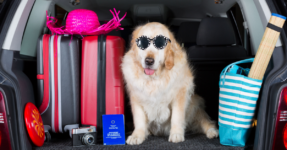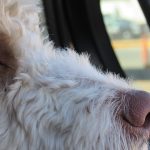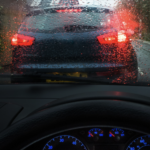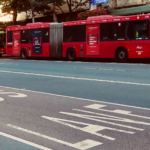The Offence of Driver Not Having Proper Control of Vehicle in NSW

Police in Slovakia had to look twice when they spotted a car going over the speed limit – the speed camera photo showed a Golden Retriever behind the wheel!
The motorist later claimed the dog jumped into his lap moments before the photo was taken, but police weren’t convinced, pointing out that the speed camera had not detected any ‘sudden movements’.
The motorist was ultimately fined for a number of driving offences, including the offence of speeding.
Driver with an unrestrained animal
While the internet has had a field day, it has to be said it’s not uncommon for drivers to have their dogs on their laps – although this is against the law in all states and territories in Australia.
Laws differ slightly across jurisdictions, but all require drivers to have proper control of a vehicle, with a clear and unobstructed view ahead, to both sides, and the rear.
Travelling animals must be restrained
In New South Wales, the law is also very specific about dogs being restrained – one of the many reasons being that a pup can cause distraction.
Many owners simply opt for a car restraint, easily available from most pet stores, these simply plug into any existing seatbelt port.
And while there is no specific rule about your dog having his head out the window to enjoy the rich smells through the journey, they do need to be safely restrained.
Indeed, a dog can become a projectile in an accident and hurt not only themselves, but other occupants within the vehicle.
Similarly, if the dog is in the front seat, they could be seriously injured by the activation of an airbag.
Drivers need to take due care. It’s also important to consider whether you want to tether your dog by the neck, which could cause injury if you stop suddenly, or preferably via a body harness.
The traffic offence of driver not having proper control of vehicle
Regulation 297(1) of the Road Rules 2014 (NSW) states that a person must not drive a vehicle unless the driver has proper control of it.
Regulation 297(1A) specifies that a person must not drive a vehicle with an animal in the person’s lap.
And Regulation 297(2) provides that a person must not drive a motor vehicle unless he or she has a clear view of the road, including traffic ahead, behind and to each side of the driver.
The penalty notice for the offence currently carries three demerit points and a fine of $469, or 4 demerit points and $587 in a school zone.
The maximum penalty is 20 penalty units where the matter is dealt with by a court.
One New South Wales penalty unit is currently equivalent to $110.
What is a ‘vehicle’?
Regulation 15 states that a vehicle includes:
- a motor vehicle, trailer and tram,
- a bicycle,
- an animal-drawn vehicle, and an animal that is being ridden or drawing a vehicle,
- a motorised wheelchair that can travel at over 10 kilometres per hour (on level ground), and
- an electric skateboard.
The definition does not include a wheelchair not capable of travelling over 10 kilometres per hour, a train, or a wheeled recreational device or wheeled toy.
What is a ‘motor vehicle’?
The dictionary contained in the Road Rules defines a motor vehicle as vehicle, other than a bicycle, that is built to be propelled by a motor that forms part of the vehicle.
Rules for motorcyclists, ute drivers and bicycles
There are a range of rules that apply to those who use means of transport other than standard passenger vehicles. These include:
- A motorcycle rider must not ride with an animal between the handlebars and the rider.
- Dogs on the back of utes should be restrained either via a tether or cage, so that the dog cannot fall off or be injured when the vehicle moves.
- A driver, motorcycle rider, bicycle rider or passenger must not lead an animal, while the vehicle is moving.
As the driver, the animal in your car is your responsibility, and there are harsh penalties for not obeying the road rules.
Prevention of Cruelty to Animals Act
It is also important to be aware that the Prevention of Cruelty to Animals Act 1979 (NSW) prescribes rules relating to the carriage and conveyance of animals.
In that regard, section 7 of the Act provides as follows:
(1) A person shall not:
(a) carry or convey an animal, or
(b) where the person is a person in charge of an animal – authorise the carriage or conveyance of the animal,
in a manner which unreasonably, unnecessarily or unjustifiably inflicts pain upon the animal.
Maximum penalty: 250 penalty units in the case of a corporation and 50 penalty units or imprisonment for 6 months, or both, in the case of an individual.
(2) Without limiting the generality of subsection (1), a person shall not:
(a) carry or convey a horse on a multi-deck vehicle, or
(b) where the person is a person in charge of the horse – authorise the carriage or conveyance of a horse on a multi-deck vehicle.
Maximum penalty: 250 penalty units in the case of a corporation and 50 penalty units or imprisonment for 6 months, or both, in the case of an individual.
(2A) Without limiting subsection (1), a person must not carry or convey a dog (other than a dog being used to work livestock), on the open back of a moving vehicle on a public street unless the dog is restrained or enclosed in such a way as to prevent the dog falling from the vehicle.
Maximum penalty: 50 penalty units or imprisonment for 6 months, or both.
Again, a penalty unit is currently worth $110 in New South Wales.
Leaving animals in cars
In New South Wales is not an offence to lock an animal in car, but owners need to take care, particularly with summer coming.
The RSPCA says it only takes 6 minutes for an animal to die in a hot car.
Under the Prevention of Cruelty to Animals Act, leaving an animal in a hot car can amount to an act of cruelty, and the RSPCA has the power to investigate and take action against owners if it believes an offence has been committed.







